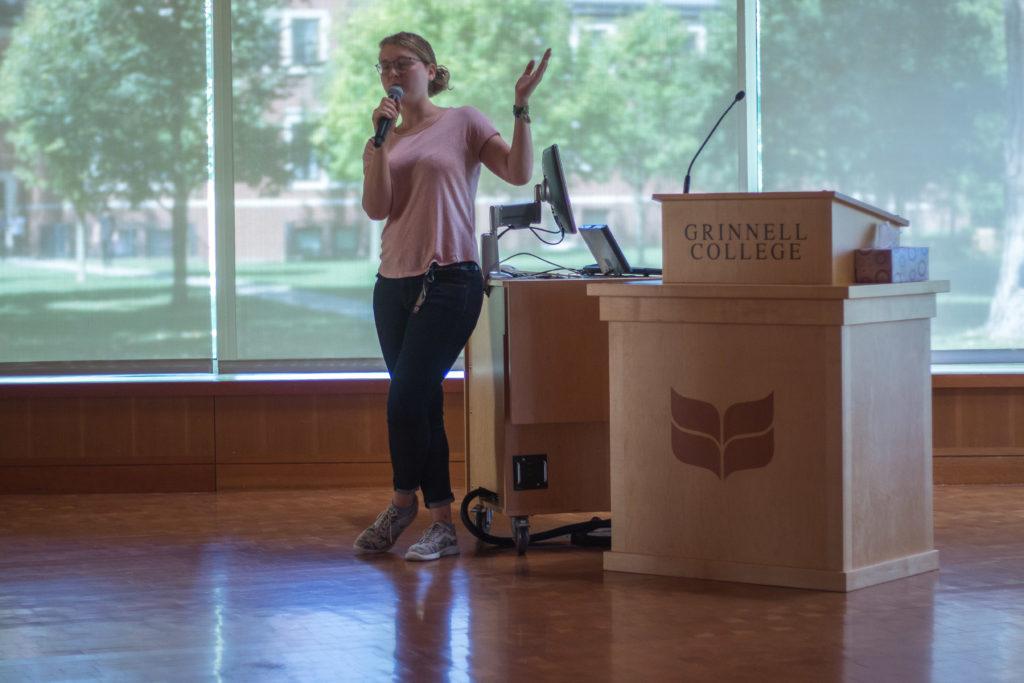The Peace and Conflict Studies (PACS) Committee marked the International Day of Peace yesterday with a screening of Misha Gelnarova ’18 and Matt McCarthy ’17’s short film “Nilob’s Story.” Established by the United Nations General Assembly in 1981, the International Day of Peace calls for a 24-hour ceasefire in conflict and war zones so that relief agencies may safely enter areas where violence usually prevents the distribution of vaccines, medical care, food and books. Additionally, PACS takes the opportunity of the Day of Peace to hold programming that relates global conflicts to Grinnell students.
This year’s International Day of Peace was specifically dedicated to shedding light on the global refugee crisis. When considering what programming to hold, PACS found that Gelnarova and McCarthy’s documentary on Grinnell alumna and Afghanistani refugee Nilob Nahib ’13’s upbringing in the Czech Republic was the obvious choice.
“We thought this was pretty relevant, especially with the recent travel ban,” said Ala Akkad ’19, a member of the PACS committee who helped organize the event. “I think it’s something that will interest more Grinnell students because it’s something that’s more real when you think about the context of a student who’s gone through it.”
Gelnarova and McCarthy received funding to produce “Nilob’s Story” in 2016 through Davis Projects for Peace, which awards $10,000 to projects that promote global peace. Gelnarova, who is from the Czech Republic, was inspired to document a story of the refugee crisis in Eastern Europe as a response to increasingly violent anti-refugee rhetoric on the Czech public and political stage.

“Being so far away from home and reading the news was really scary, because there were several rallies against Islam, against immigration, against refugees,” Gelnarova said. “One of the most prominent speakers of this movement, literally called ‘We don’t want Islam in the Czech Republic’ … And then he appeared on the same stage as the Czech president. There was no one really speaking against that, from the political arena.”
Gelnarova met up with McCarthy while he was studying abroad in Prague, and together they decided to make a film revealing the true story of a refugee in the Czech Republic. Gelnarova knew Nahib, who worked in Grinnell College’s Intercultural Affairs office following graduation. She recognized that Nahib’s story, about an Afghanistani girl who moved with her family to the Czech Republic following the Taliban’s rise to power in 1996 and then ended up at Grinnell College, would allow the global refugee crisis to resonate with a college audience. Although the documentary was originally intended to be entirely comprised of live action film, safety concerns brought Gelnarova and McCarthy to create an animated movie instead.
“A month before we were supposed to meet up with Nilob in the Czech Republic, there was an attack on different businesses and coffee shops that are hate-free. [Domestic terrorists] destroyed one of the community centers that welcomed refugees. … It seemed like it was getting really violent, so we talked to Nilob about the safety. … If there was her face [in the documentary], it would put her in danger, and her family.”
Gelnarova and McCarthy then sought out Czech university art students to animate the film. They collaborated with two Czech art students, who created watercolor-like animation for the final product.
In “Nilob’s Story,” the voices of a narrator along with Nahib herself relate the story of how Nahib and her family fled Afghanistan to escape Taliban rule and then made their home in the Czech Republic. Her story largely focuses on how her family did eventually feel at home in the Czech Republic, by finding a home after three years in a refugee camp and becoming fluent in Czech. Towards the end of the documentary, however, Nahib also relates anecdotes of how in recent years, anti-refugee and anti-Islam rhetoric has intensified in the country, coming even from people she considered friends.
Professor Todd Armstrong, Russian, introduced the event and facilitated discussion. Armstrong discussed the project in relation to his own interest in Central and Eastern European studies.
The Czech Republic would benefit from Gelnarova and McCarthy’s project “[g]iven [Eastern Eurpoe’s] geographical location at the crossroads of East and West, North and South, and the burden that a mass of refugee population can bring to a small country” Armstrong said.
Gelnarova also acknowledged the geographic significance of the refugee crisis in the Czech Republic, as many Czech people were once refugees themselves.
“There’s this history of running away from the Czech Republic when were under the Iron Curtain. We were received in all parts of the world, we were refugees as well. Now it’s seen from a very different point of view.”
In addition to its screening at Grinnell College, “Nilob’s Story” was distributed to over 70 Czech and Slovakian high schools for student lessons. The project was supported by a Czech organization that creates worksheets and lesson plans for high school students about global issues, and can be accessed at www.usou.cz.



























































